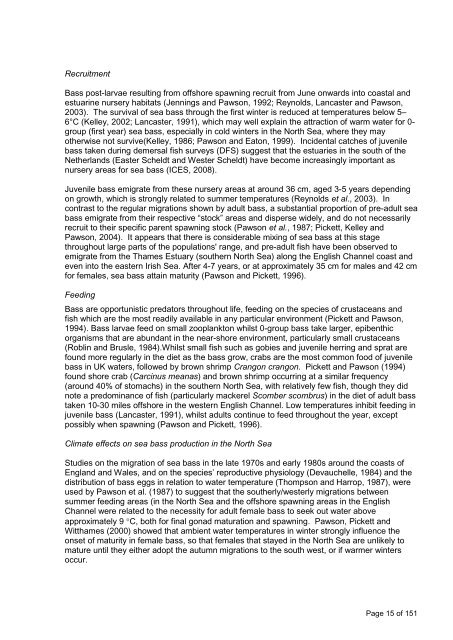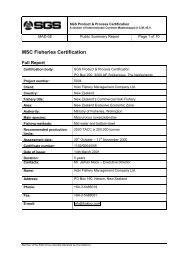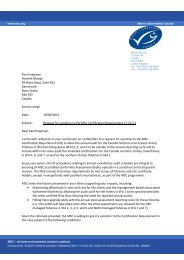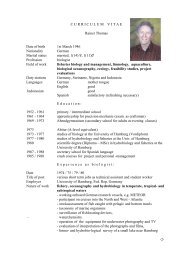SGS Product & Process Certification - Marine Stewardship Council
SGS Product & Process Certification - Marine Stewardship Council
SGS Product & Process Certification - Marine Stewardship Council
You also want an ePaper? Increase the reach of your titles
YUMPU automatically turns print PDFs into web optimized ePapers that Google loves.
Recruitment<br />
Bass post-larvae resulting from offshore spawning recruit from June onwards into coastal and<br />
estuarine nursery habitats (Jennings and Pawson, 1992; Reynolds, Lancaster and Pawson,<br />
2003). The survival of sea bass through the first winter is reduced at temperatures below 5–<br />
6°C (Kelley, 2002; Lancaster, 1991), which may well explain the attraction of warm water for 0group<br />
(first year) sea bass, especially in cold winters in the North Sea, where they may<br />
otherwise not survive(Kelley, 1986; Pawson and Eaton, 1999). Incidental catches of juvenile<br />
bass taken during demersal fish surveys (DFS) suggest that the estuaries in the south of the<br />
Netherlands (Easter Scheldt and Wester Scheldt) have become increasingly important as<br />
nursery areas for sea bass (ICES, 2008).<br />
Juvenile bass emigrate from these nursery areas at around 36 cm, aged 3-5 years depending<br />
on growth, which is strongly related to summer temperatures (Reynolds et al., 2003). In<br />
contrast to the regular migrations shown by adult bass, a substantial proportion of pre-adult sea<br />
bass emigrate from their respective ―stock‖ areas and disperse widely, and do not necessarily<br />
recruit to their specific parent spawning stock (Pawson et al., 1987; Pickett, Kelley and<br />
Pawson, 2004). It appears that there is considerable mixing of sea bass at this stage<br />
throughout large parts of the populations' range, and pre-adult fish have been observed to<br />
emigrate from the Thames Estuary (southern North Sea) along the English Channel coast and<br />
even into the eastern Irish Sea. After 4-7 years, or at approximately 35 cm for males and 42 cm<br />
for females, sea bass attain maturity (Pawson and Pickett, 1996).<br />
Feeding<br />
Bass are opportunistic predators throughout life, feeding on the species of crustaceans and<br />
fish which are the most readily available in any particular environment (Pickett and Pawson,<br />
1994). Bass larvae feed on small zooplankton whilst 0-group bass take larger, epibenthic<br />
organisms that are abundant in the near-shore environment, particularly small crustaceans<br />
(Roblin and Brusle, 1984).Whilst small fish such as gobies and juvenile herring and sprat are<br />
found more regularly in the diet as the bass grow, crabs are the most common food of juvenile<br />
bass in UK waters, followed by brown shrimp Crangon crangon. Pickett and Pawson (1994)<br />
found shore crab (Carcinus meanas) and brown shrimp occurring at a similar frequency<br />
(around 40% of stomachs) in the southern North Sea, with relatively few fish, though they did<br />
note a predominance of fish (particularly mackerel Scomber scombrus) in the diet of adult bass<br />
taken 10-30 miles offshore in the western English Channel. Low temperatures inhibit feeding in<br />
juvenile bass (Lancaster, 1991), whilst adults continue to feed throughout the year, except<br />
possibly when spawning (Pawson and Pickett, 1996).<br />
Climate effects on sea bass production in the North Sea<br />
Studies on the migration of sea bass in the late 1970s and early 1980s around the coasts of<br />
England and Wales, and on the species‘ reproductive physiology (Devauchelle, 1984) and the<br />
distribution of bass eggs in relation to water temperature (Thompson and Harrop, 1987), were<br />
used by Pawson et al. (1987) to suggest that the southerly/westerly migrations between<br />
summer feeding areas (in the North Sea and the offshore spawning areas in the English<br />
Channel were related to the necessity for adult female bass to seek out water above<br />
approximately 9 C, both for final gonad maturation and spawning. Pawson, Pickett and<br />
Witthames (2000) showed that ambient water temperatures in winter strongly influence the<br />
onset of maturity in female bass, so that females that stayed in the North Sea are unlikely to<br />
mature until they either adopt the autumn migrations to the south west, or if warmer winters<br />
occur.<br />
Page 15 of 151





